What's new in iManage Work
New features are continuously being added to iManage Work. See what enhancements and feature changes are available in each update.
Ability to update and save the search criteria of a search folder
Ability to keep users' choices for the Docs & Emails search type
Enhancements to filtering emails in Docs & Emails search results
Selecting lookup search match type for custom metadata fields
Opening emails filed from Gmail, in Gmail using the right-click context menu
10.4.8
Update folder security and apply changes to its children
As an iManage Work user, you can now update the security details of a folder and also apply the changes to the folder’s children (subfolders, documents, and so on). For a folder, you can:
Add or remove a user/group
Edit user/group access level
Enable/Disable Inherit security from parent
Edit the default security
After updating the folder security, you can preview the changes and adjust Exceptions and Settings before applying those changes to the folder’s children.
After saving your changes, you can choose how to apply them to the folder children:
Apply changes only: Preserves different security while appending new users, changing default security, and so on.
Overwrite security: Aligns all permissions to the parent folder, removing any customized permissions.
After the new security changes are applied, the status of all Apply security to contents actions can be seen in the Notifications panel accessible through the bell icon.
Figure: Updating folder security and applying changes to its children
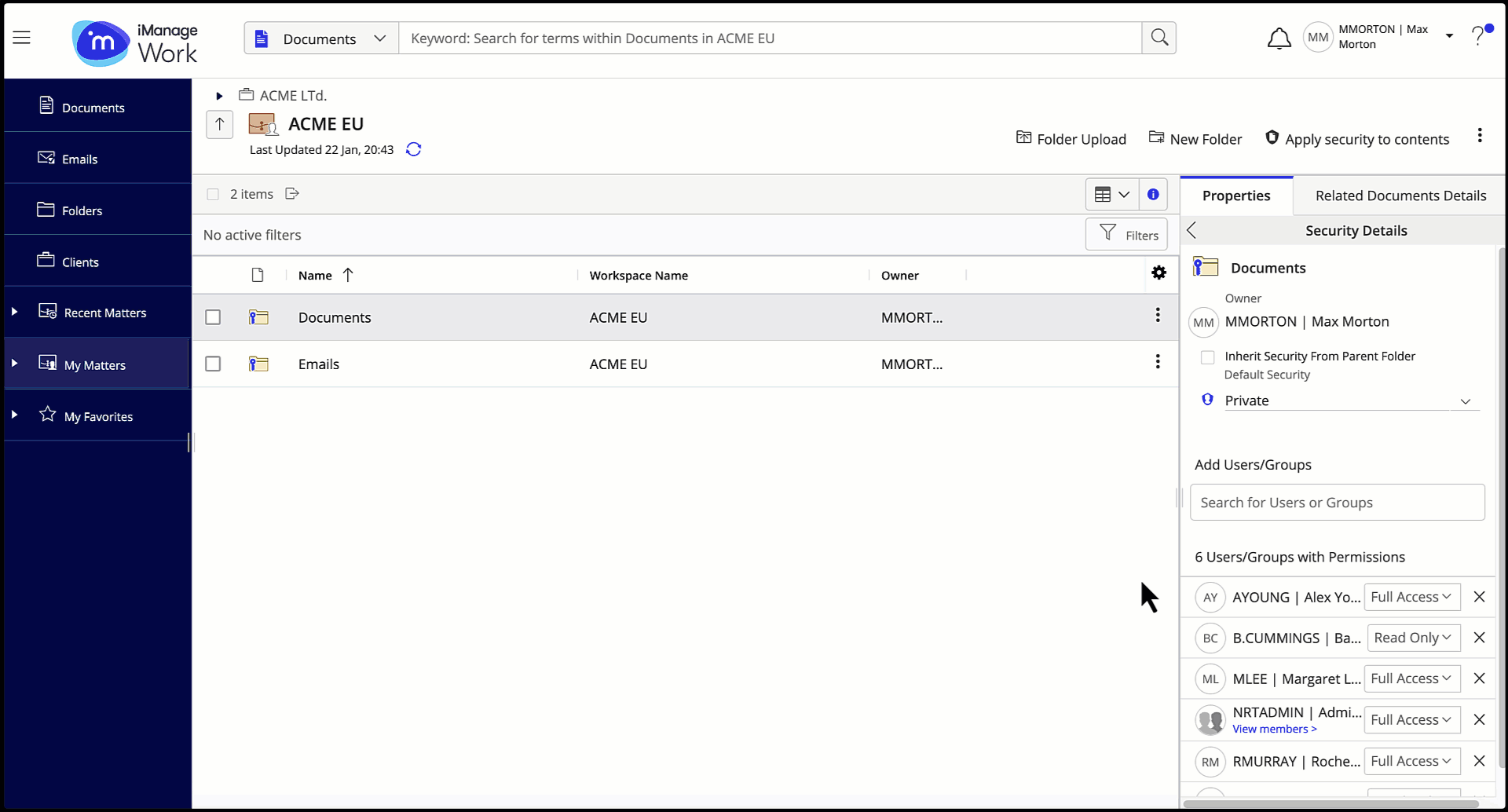
NOTE:
Updating a folder security and applying the changes to its children isn't supported for:
Search folder
iManage Share (Blue) folder
Folder shortcut
Prompt for security update when moving a folder or document
When moving an item (folder or a document) from one parent to the other, iManage Work now prompts you to update the security of the item as per the security of the new parent. The Match security to destination dialog lets you select either Match security to destination or Keep current security for items being moved.
The security of items moved from one container to the other is effective only if:
You have full access to the items
The source and the destination folder exist within the same database.
Figure: Updating security when moving a folder or document
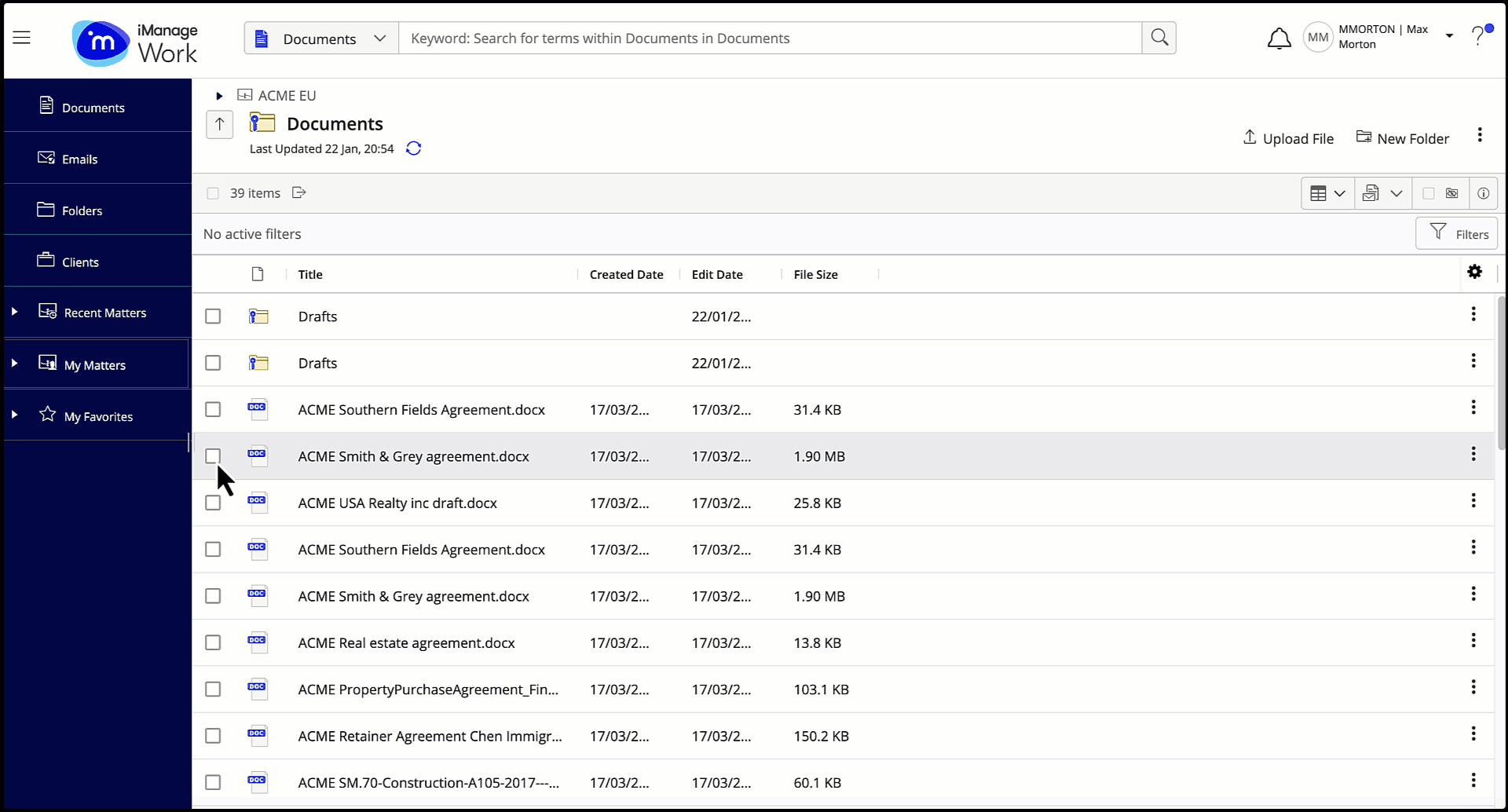
Selecting multiple documents and subfolders in a folder and aligning security to that of the folder
You can now select multiple documents and subfolders within a folder and easily update their security to align to that of the folder.
Figure: Aligning security with the parent folder for documents
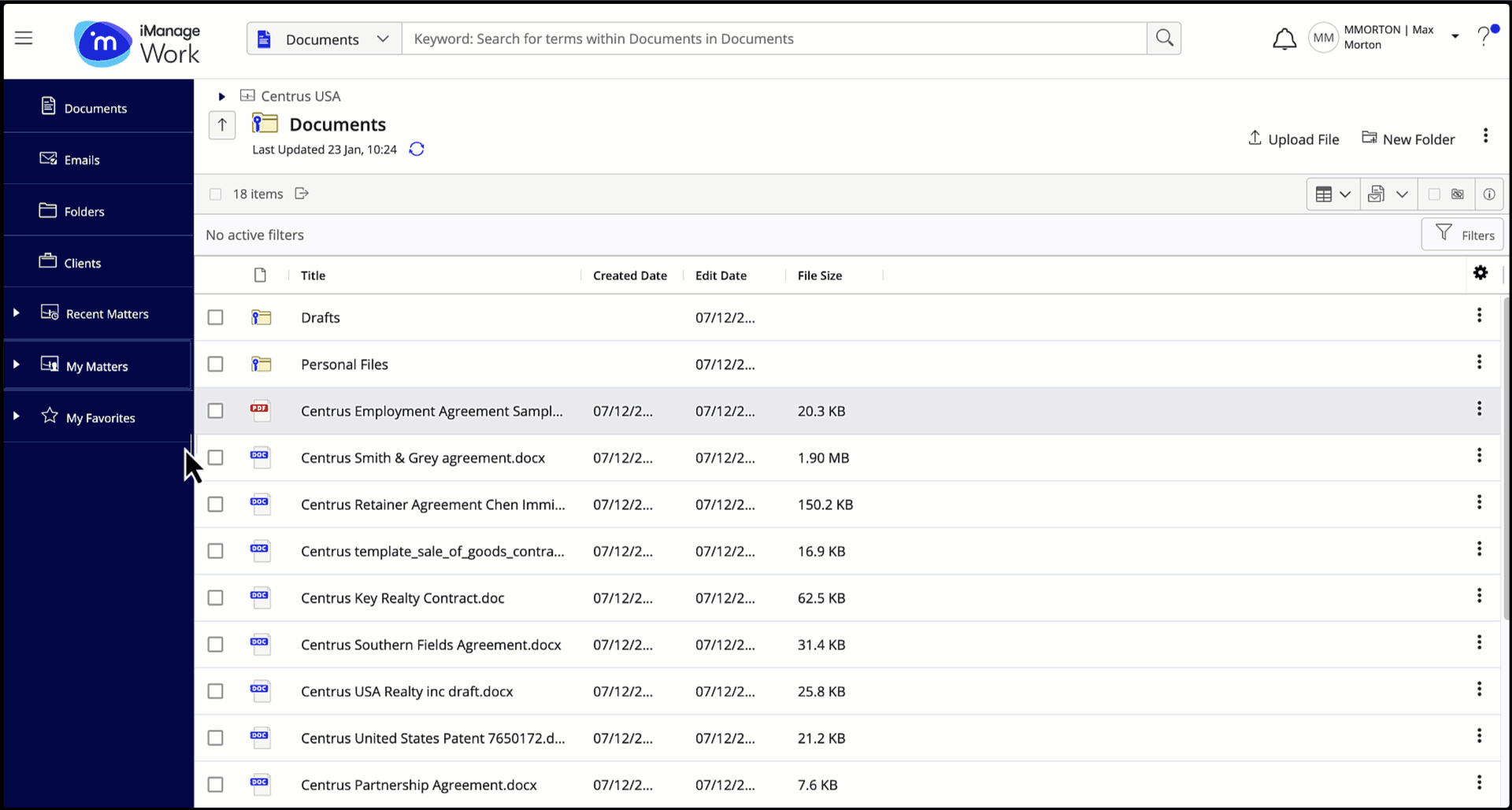
NOTE:
This feature isn't supported for:
Saved search folders
Recent documents / Recent emails list
Selecting multiple folders in a workspace or folder and aligning security to that of the parent workspace or folder
You can now select multiple folders within a workspace or folder and easily update their security to align to that of the parent workspace or folder.
Figure: Aligning security with the parent workspace or folder
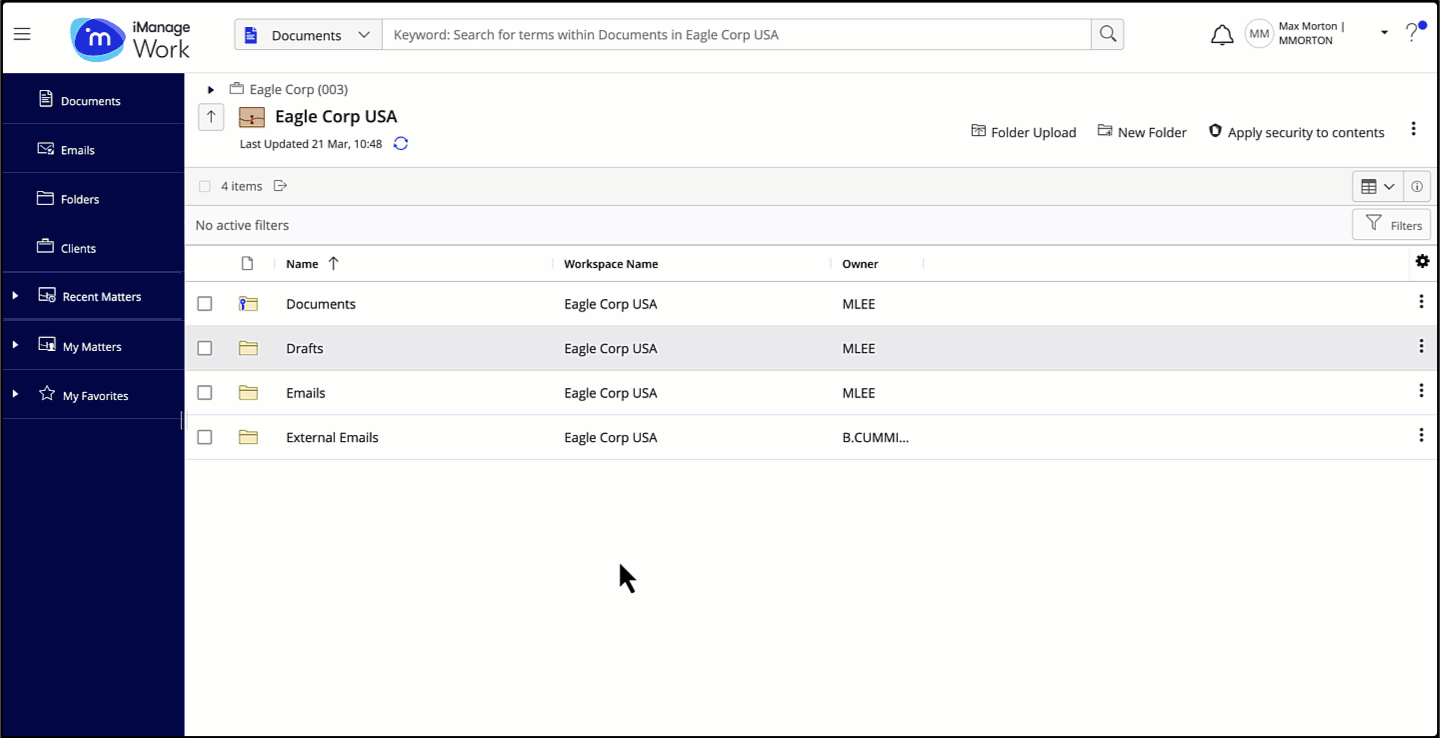
NOTE:
This feature isn't supported for Recent document folders/Recent email folders list.
This feature is supported for Saved search folders, but the security changes aren't propagated to documents in the saved search folders.
Applying workspace or folder security to its children
As an iManage Work user, you can now apply the security details of a workspace or folder to its children (subfolders, documents, and so on). For folders, you can select single or multiple folders and apply security to their children.
Applying workspace or folder security will align all permissions on the contents (wherever you’ve got Full Access and based on the Exceptions & Settings chosen) to match the workspace or folder, removing any customized permissions.
Figure: Applying workspace security to its children
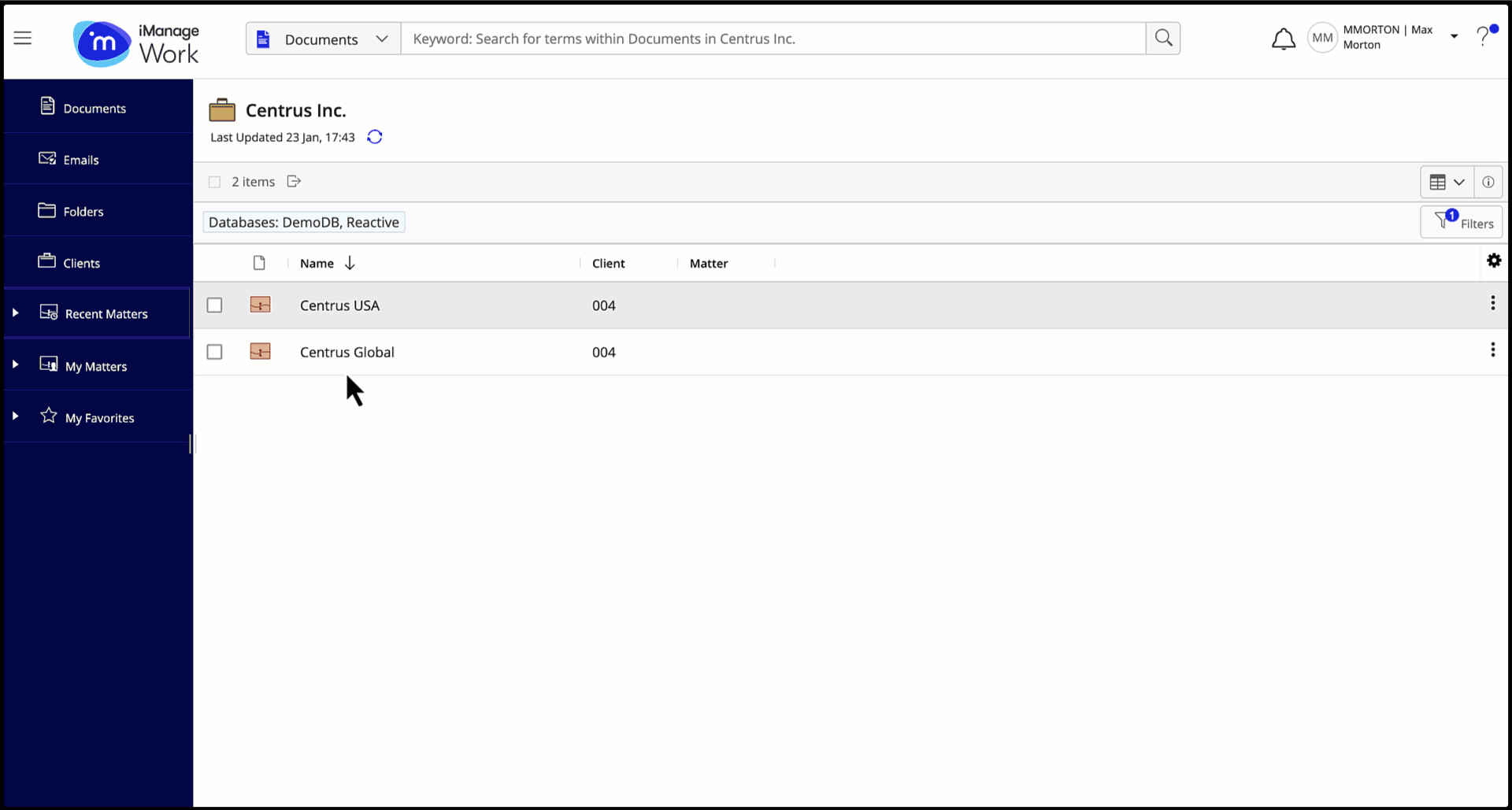
Figure: Applying folder security to its children
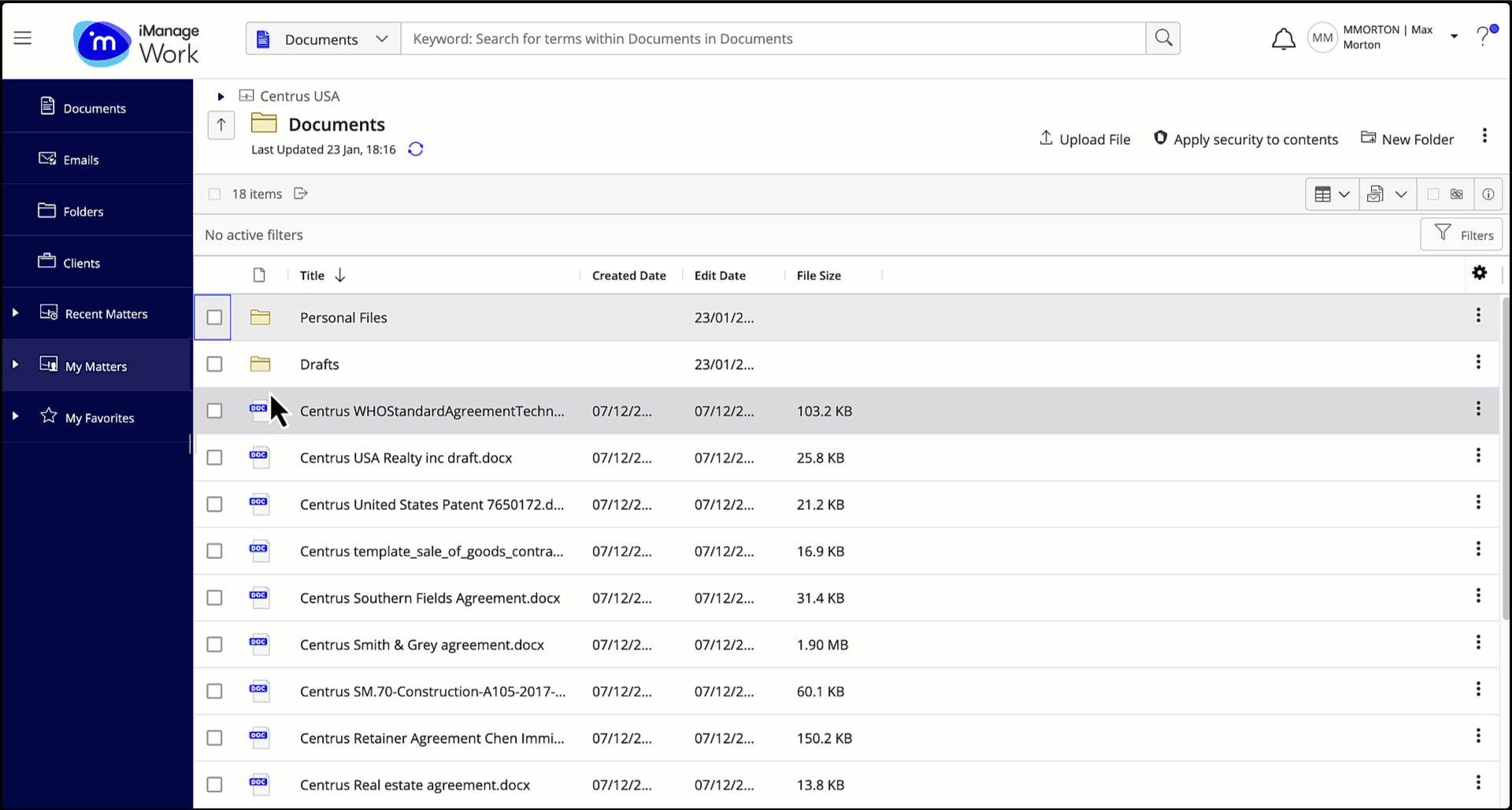
NOTE:
Applying security to children isn't supported for:
Saved search folder
iManage Share (Blue) folder
Folder shortcut
Searching for items within a search folder
This release of iManage Work introduces the ability to search within a search folder using the Current Location scope in the search scope drop-down, which lets you perform a more focused search for items (documents or emails) within a saved search folder.
Figure: Searching for items within a search folder
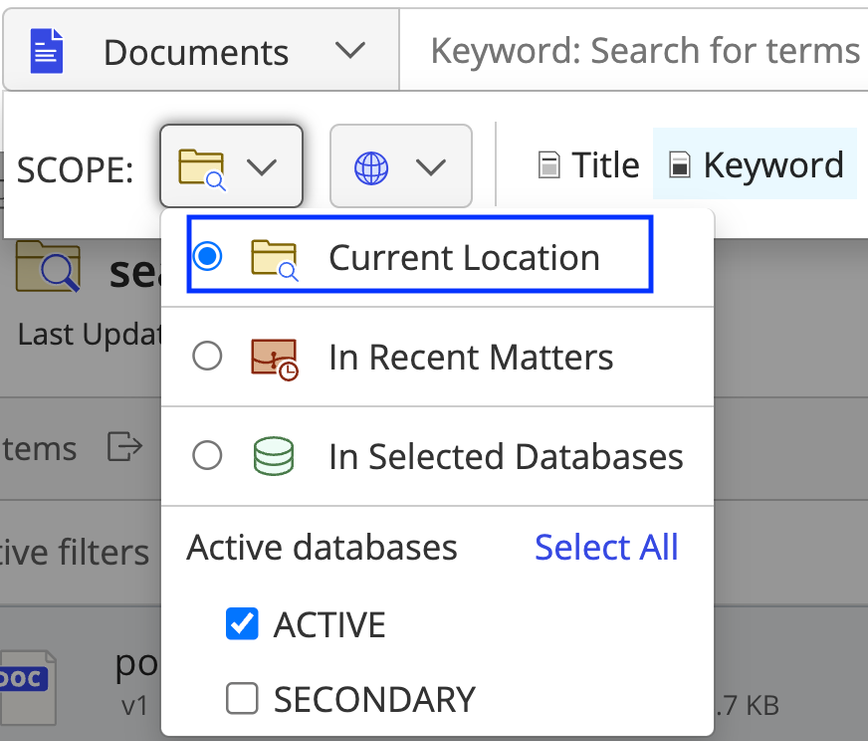
NOTE:
The Current Location scope functionality can be used only when the search folder's results are all within the same database as the search folder.
The Current Location scope uses the Simple Search form. Searching for specific criteria from the Advanced Search form isn't supported.
10.4.7
Enhanced edit security workflow
This release of iManage Work introduces two enhancements to the Edit user/group permissions feature, aimed at reducing the effort required in updating the Access Control Level (ACL) for multiple items.
You can now update the security of a single document or all versions of a single document using the Edit user/group permissions feature from the right-click context menu or toolbar menu.
Figure: Updating security for a single document

When updating the security of a single or multiple documents in a single action, you can now also update the Default Security from the Edit user/group permissions dialog box. The available options are:
Public: All users can view the item and edit the content.
View: All users can view the item, but won't be able to edit the content.
Private: Only the author can view and edit the content, unless other users are given specific permissions.
Figure: Updating default security from edit user/permissions dialog box

After making the changes, you can preview them along with the Exceptions and Settings before applying those changes.
Figure: Exceptions and settings
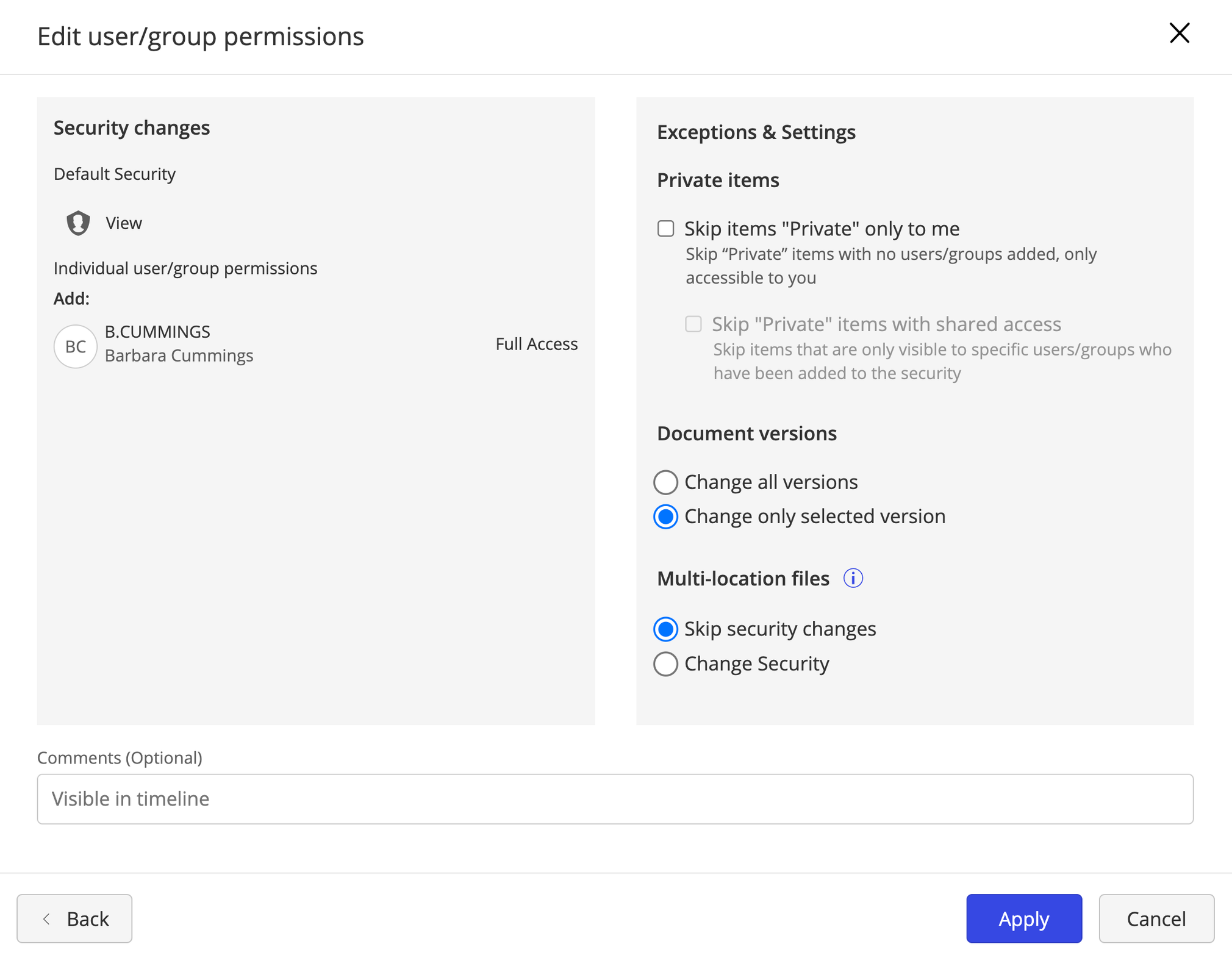
After the new settings are applied, status of all Edit user/group permissions actions can be seen in the Notifications panel accessible through the Bell icon.
Figure: Notifications panel
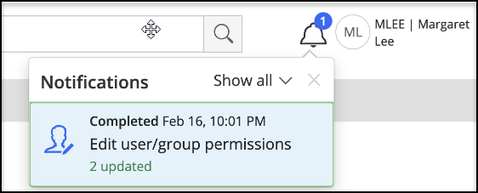
Opening multiple files in native apps on Windows
This release of iManage Work introduces the ability to select and open multiple files in their native applications. With iManage Work Desktop for Windows installed on your computer, you can select upto 50 files at once. For these files, you can perform the Open and Open read-only actions from the multi-select toolbar or, the right-click context menu. These actions are available for files in:
Document folders
Search results
Saved search folders
NOTE:
Open and Open read-only actions aren't configurable in iManage Control Center.
Figure: Opening multiple files using native apps

When you select more than 20 files, an alert message is displayed to indicate that opening multiple files might slow down your computer’s performance and, you can choose to either proceed or cancel the operation.
The progress panel displays the status of the files being opened.
Figure: Progress panel
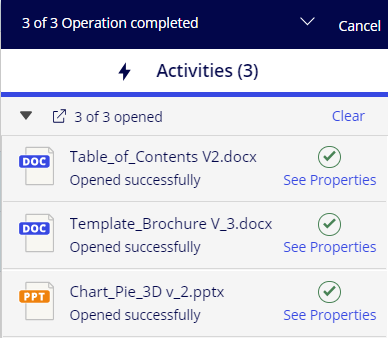
Depending on the type of file selected, the behavior varies as explained in the table below.
Table: Behavior of file type for when opening in native apps
|
| ||
|---|---|---|---|
Open | Open (file checked out by other users) | Open read-only | |
Microsoft Office documents | Open in Edit mode | Open read-only | Open read-only |
Open in Edit mode | Open read-only | Open read-only | |
Non Microsoft Office documents | Open in Edit mode (Native desktop app) | Open read-only (Native desktop app) | Open read-only (Native desktop app) |
Emails (.msg or .eml) NOTE: If Enable open in Gmail is turned on in iManage Control Center, then selecting multiple Gmail emails opens only the first selected email in the Gmail Web client due to browser limitations | Open in the configured email application | Not applicable | Open in the configured email application |
Persisting in the tree state after a timeout
The Tree View state in the user interface now persists when you sign in to iManage Work after a timeout.
When working across multiple workspaces or engagements, you don't have to open the nested folder structure every time the session times out. iManage Work allows you to return to the same location on the tree where you were working, before the timeout.
Figure: Maintaining the tree state after a timeout
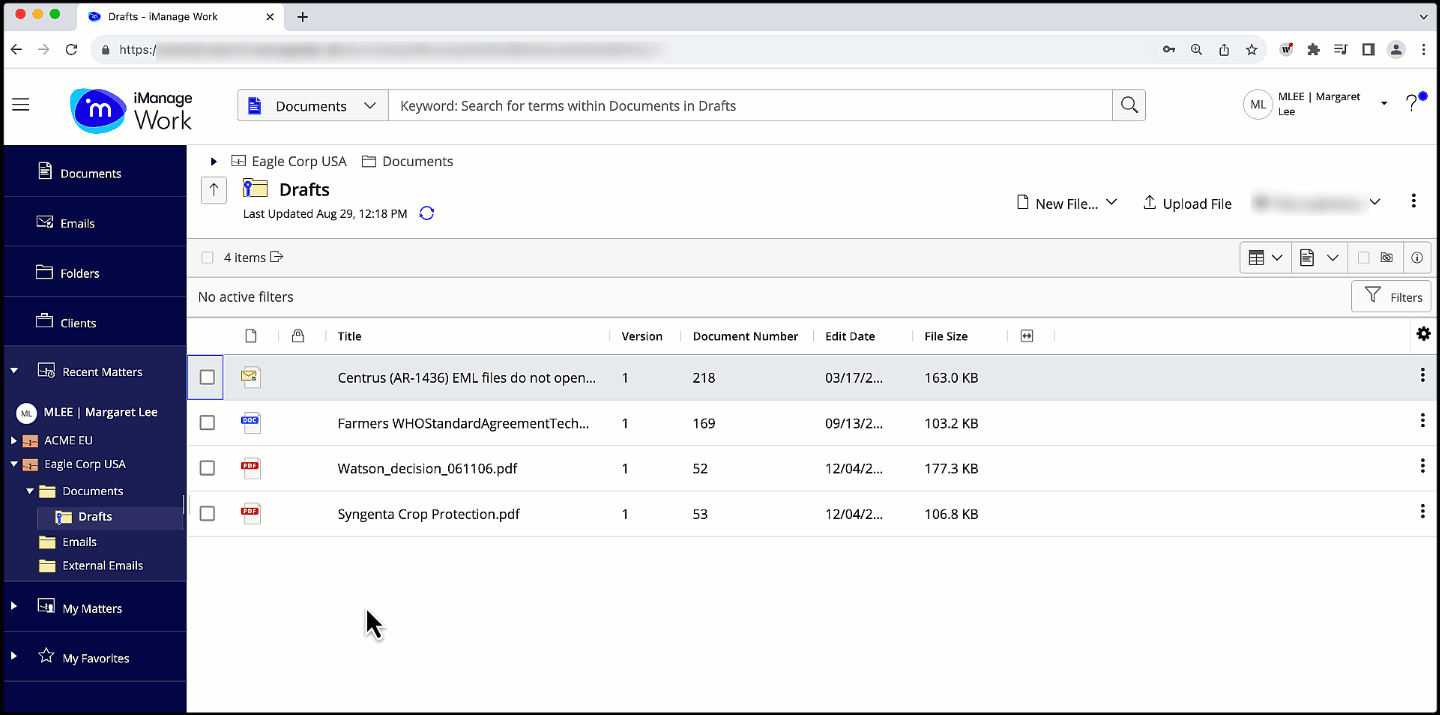
NOTE:
Even if you've set the default tab in iManage Work using the Web Default Tab settings, you'll be directed back to the same location on the tree where you were working on before your earlier session timed out.
The following behaviors apply to session timeouts and state persistence:
If a folder is renamed when your session times out, then:
iManage Work keeps the Tree View with the older name.
An error message is displayed if you select the folder.
The new folder name is displayed when you right-click the folder (or parent folder) and perform a refresh.
For deleted folders:
An error message is displayed when you select a deleted folder.
Refreshing the parent folder removes any deleted child folders and also collapses all subfolders below the child folder.
The following behaviors apply to Tree View:
Its state persists only on the same client on which you had timed out.
For example, if your session was timed out in the Work Panel for Microsoft Outlook, you can’t continue working from the same place at which you had timed out in the Work Web client.
Similarly, the Tree View state persists when you've opened iManage Work in different tabs within the same browser, but it doesn't persist across different browsers.
Selecting Clear local cached settings from User Settings drop-down list collapses the Tree View to the default view.
Ability to save database scope selection in searches
This release of iManage Work introduces the ability to explicitly save your database selection for searches and filters in recent lists from the search Scope drop-down list, when you have access to multiple databases.
NOTE:
Changes saved to the database list from the search scope are synced with the database list in filters and the other way around.
Figure: Save selection option for databases in the search scope

The Save selection option appears only when you've selected or deselected a database from the Scope drop-down list.
The Save selection option disappears after you've saved your selection of preferred databases for the search.
Improved accessibility
We've made accessibility improvements to enhance support for keyboard navigation using the tab and arrow keys and clearer screen reader labeling in the following areas:
New matter dialog box
New folder dialog box
Trash dialog box
10.4.6
New search experience, now standard in iManage Work
The new search experience is now available to everyone as a standard feature. If you aren’t ready to use it yet, you can use the Coming Soon option to revert to the previous experience.
Ability to update and save the search criteria of a search folder
This release of iManage Work introduces a revised workflow, that allows you to update and save the search criteria of a search folder and re-run the same search again.
Figure: Update and save the search criteria of a search folder
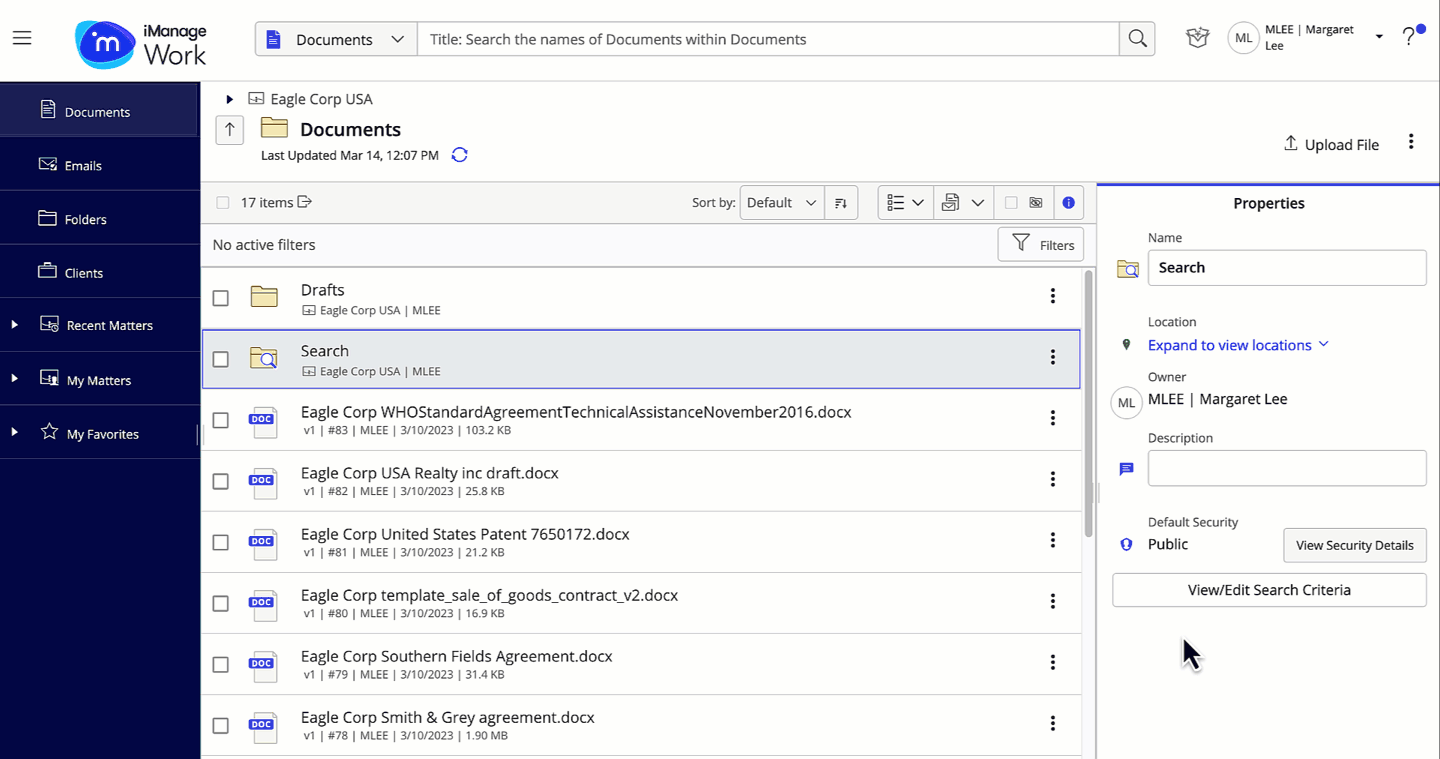
When you are in a search folder, the option to view or edit the search criteria is available in the Properties panel, folder’s toolbar or folder’s context menu. Selecting View/Edit search criteria pre-populates the following selection when the search was first run and saved:
Search criteria
Search scope
Search language
After selecting View/Edit search criteria for a search folder, you can:
Edit the search criteria and simply select Save Changes.
OREdit the search criteria, run the search again, and then select Save Changes.
NOTE:
If the language selection for search is disabled in iManage Control Center, then the language selection defaults to All Languages.
You can save the updated search criteria only if you have read/write and above access levels to the search folder.
When saving a search as a search folder, the following fields aren't supported due to server limitations:
has_attachment
removed when saving search
last_user
removed when saving search
owner
replaced by author
recipient
replaced by custom14
sender
replaced by custom13
sent_date
replaced by custom21
Viewing Recent searches in the advanced search form
Now view and run Recent searches from the advanced search form. Remove any of the displayed searches in the list by selecting X or, delete all the searches at once by selecting Clear Recent Searches.
Figure: Viewing Recent searches in the advanced search form
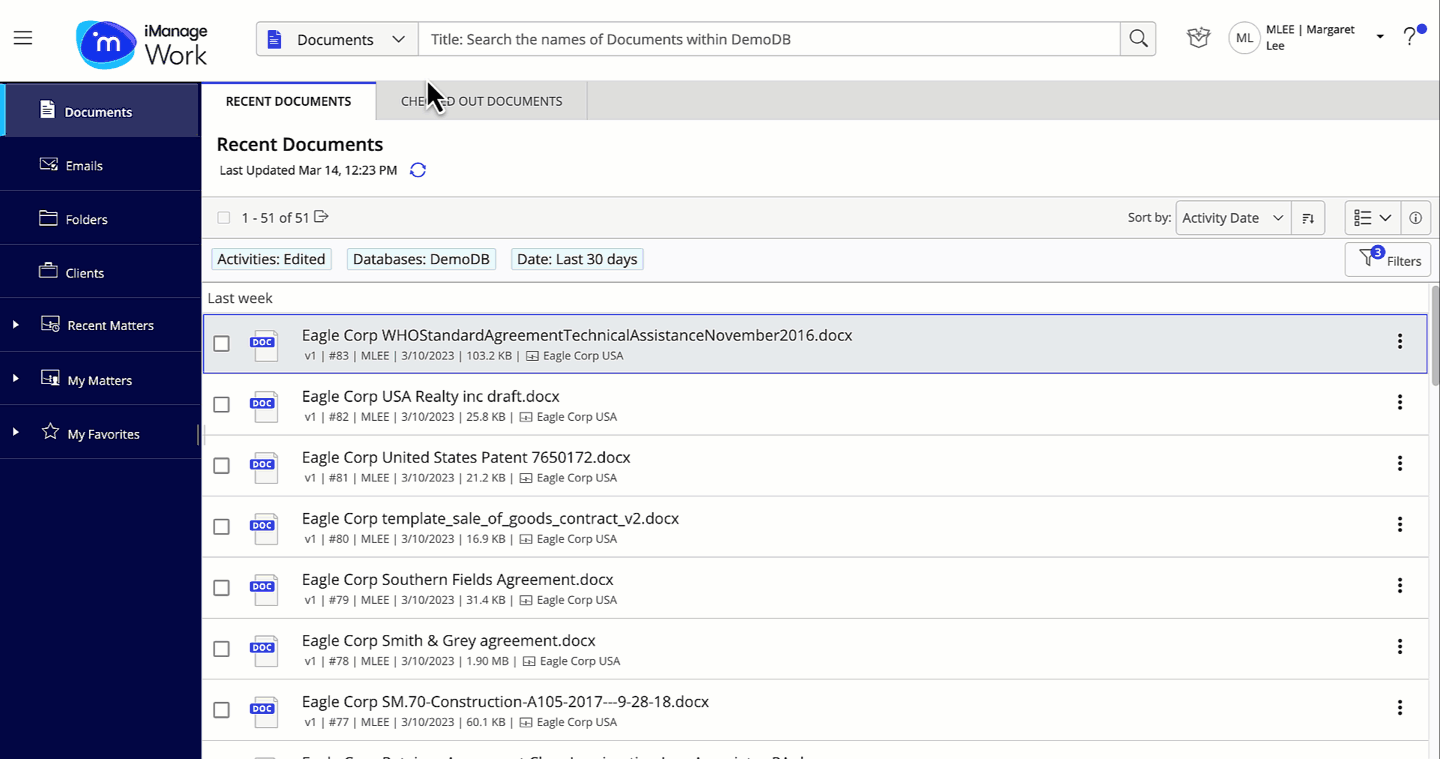
View search tips from the search interface
Search tips are now available for both simple and advanced searches. Select ? next to the advanced toggle to view tips on how to construct Boolean, phrase, or numeric searches.
Figure: Search tips in iManage Work

Ability to keep users' choices for the Docs & Emails search type
When you are in any one of the nodes in the tree in iManage Work, such as Documents, Emails, and Favorites, and then when you switch the search type to Docs & Emails in the search interface, then iManage Work remembers your choice for the selected node.
For example, when you are in the Recent Documents or Checked out Documents tab and then switch the search type from Documents to Docs & Emails in the search interface then, the search type defaults to Docs & Emails when you return to search for documents in the Recent Documents or Checked out Documents tab.
Similarly, when you are in the Recently Filed Emails or Emails Filed By Me tab and then switch the search type from Emails to Docs & Emails in the search interface then, the search type defaults to Docs & Emails when you return to search for emails in Recently Filed Emails or Emails Filed By Me tab.
Figure: Keeping users' choices for Docs & Emails search
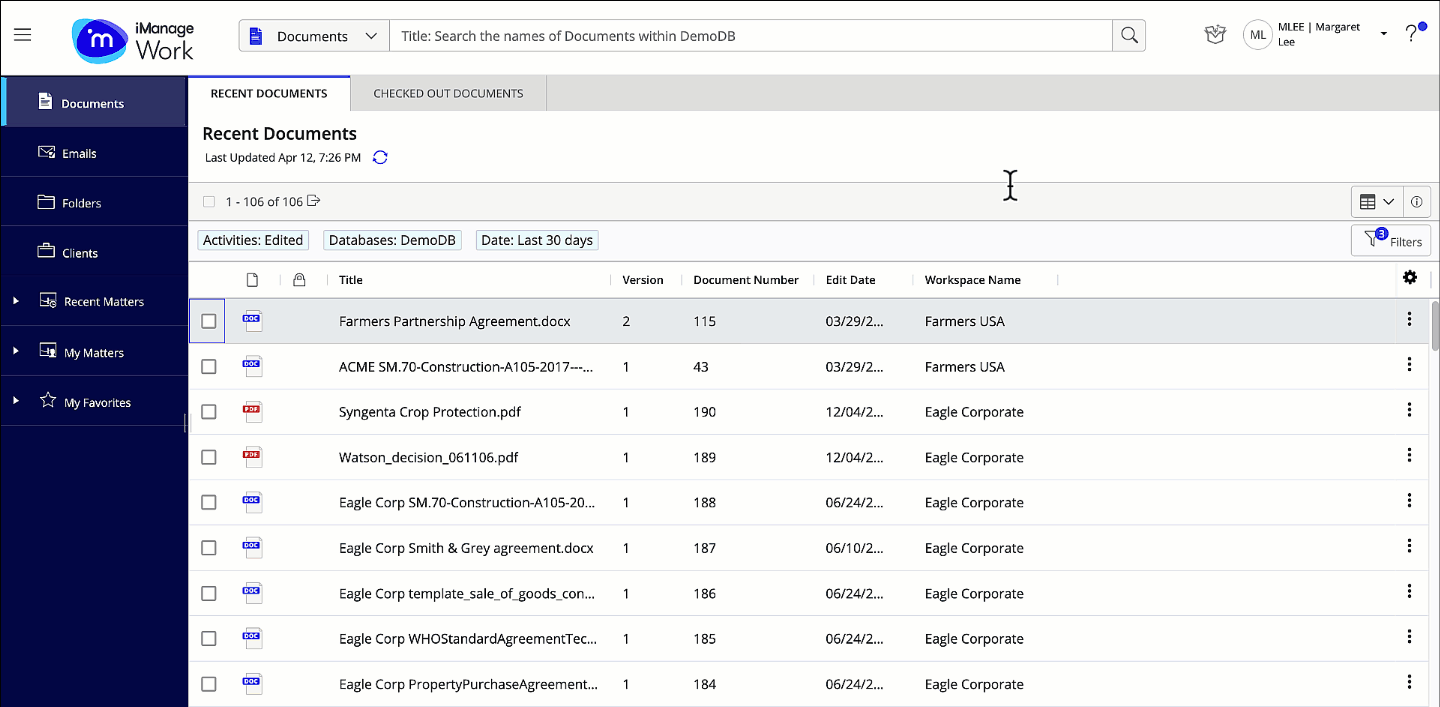
Enhancements to filtering emails in Docs & Emails search results
After performing a search using the Docs & Emails search type in iManage, you can now filter emails in the search results using the Email option under the File Type filter. You can also use the Email option under the File Type filter in a document folder to filter just the emails.
Figure: Email filtering after performing a Docs & Email search
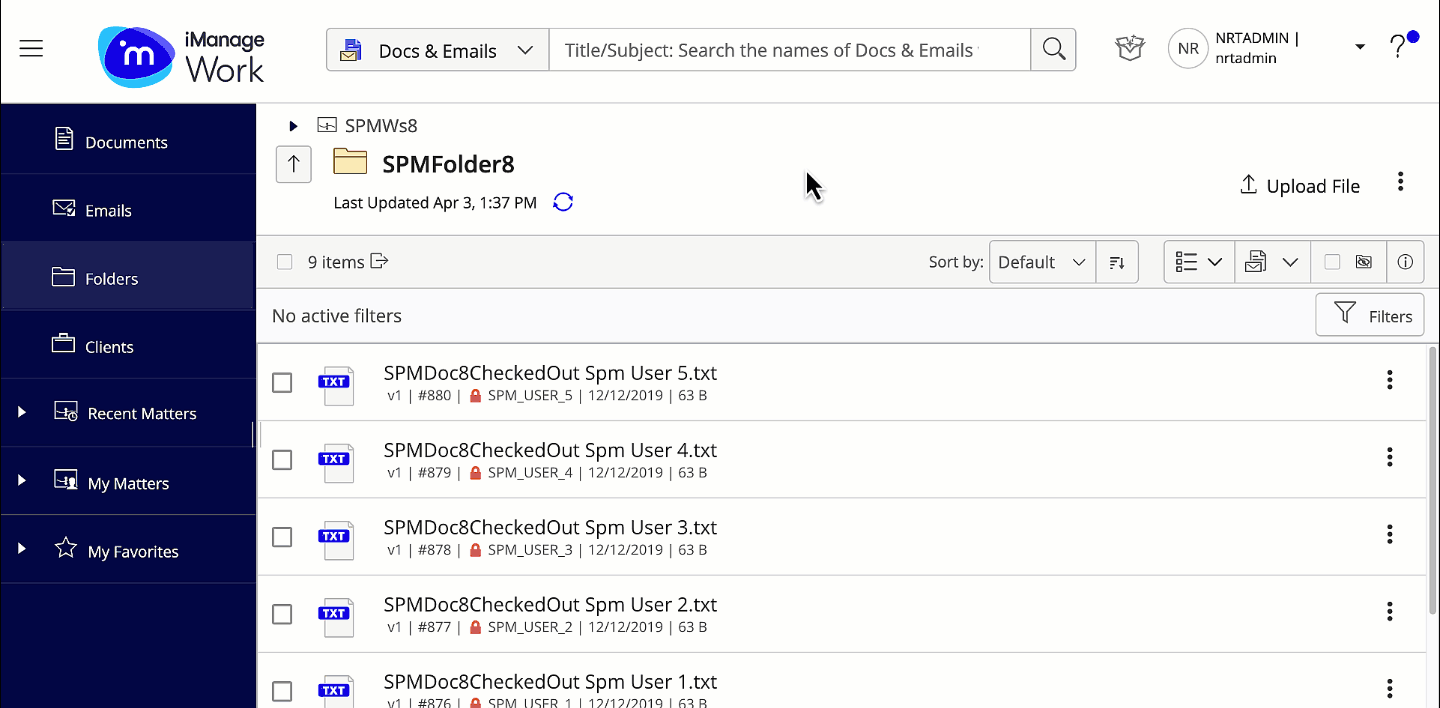
Enhancements to restoring items from Trash
When you delete/trash an item (document or email) from iManage Work, you could restore that item to the same parent folder from where it was deleted. If the parent folder was deleted, the operation failed with no option to restore the item. This release of iManage Work allows you to restore an item from Trash to a new location of your choice when the parent folder is no longer available or, if you wish to restore it to a newer location.
Figure: Restoring an item from Trash to a new location
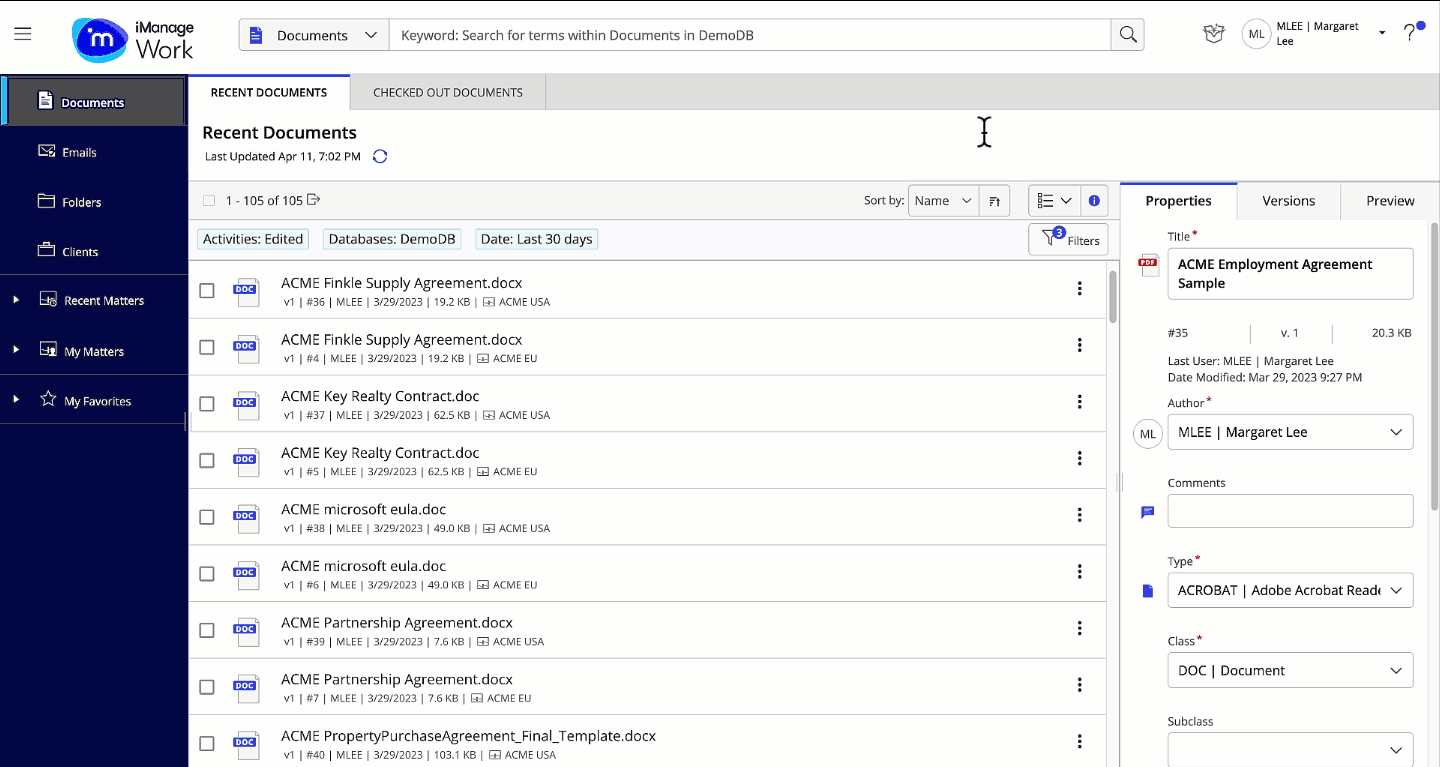
Adding commonly used file types to advanced search
When performing an advanced search for documents or emails, you can add a collection of commonly used file types to the Type lookup for the Documents and Docs & Emails search type.
The file type groups only appear when you select inside the input field, and you can continue typing to find the specific item.
The grouped file types include:
Document
Presentation
Spreadsheet
Adobe Acrobat
Emails (only applicable for Docs & Emails search types)
Figure: Adding commonly used file types to the type lookup

You can also use the Shift or Ctrl (Command for Mac) keys to add multiple file types to the Type lookup using your keyboard.
Once added:
The file types are displayed as individual pills in the Type lookup and can be removed individually.
The added file type can't be selected again from the list of available lookup types.
Selecting lookup search match type for custom metadata fields
Select the match type for searching values within the custom metadata fields in the advanced search form, using the Starts with or Contains filter, when adding a custom metadata lookup field to a search form for :
Documentse
Emails
Docs & Emails
Matters
Contains is the default filter. Match type choices are persisted until the custom metadata field is in the search form.
Figure: Selecting lookup search match type

NOTE:
The lookup search match type is available only in the advanced search form and not in the details panel lookups.
Ability to open .eml emails from iManage Work
NOTE:
This feature is only available for users who have iManage Work Desktop installed and enabled on their machine.
This release of iManage Work allows you to open .eml emails in the grid and list views from the Open right-click context menu/kebab menu as well as the preview window in iManage Work and Work Panel for Microsoft Outlook. After opening the .eml email in Outlook, you can continue performing regular actions such as Reply, Reply All, or Forward.
Figure: Opening .eml file from iManage Work
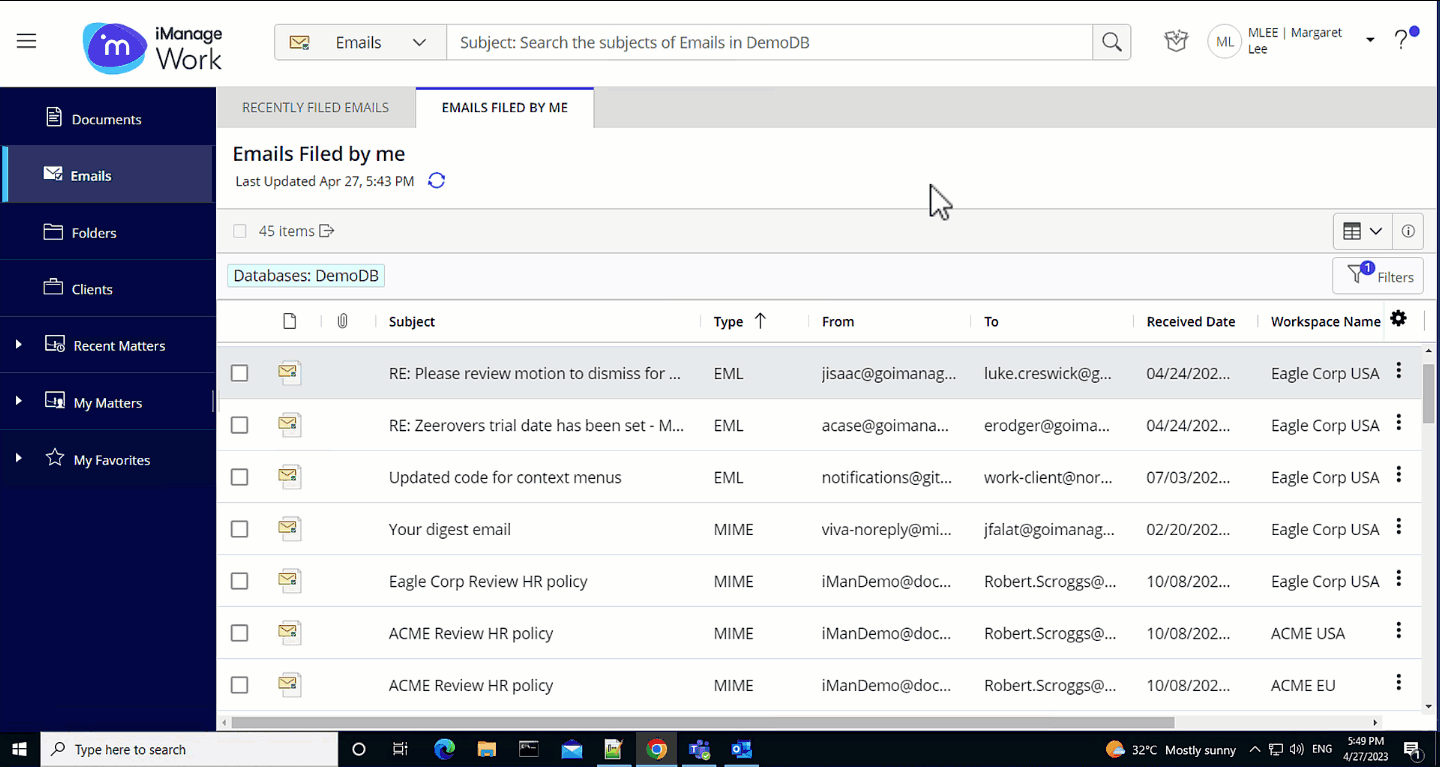
Figure: Opening .eml emails from iManage Work Panel
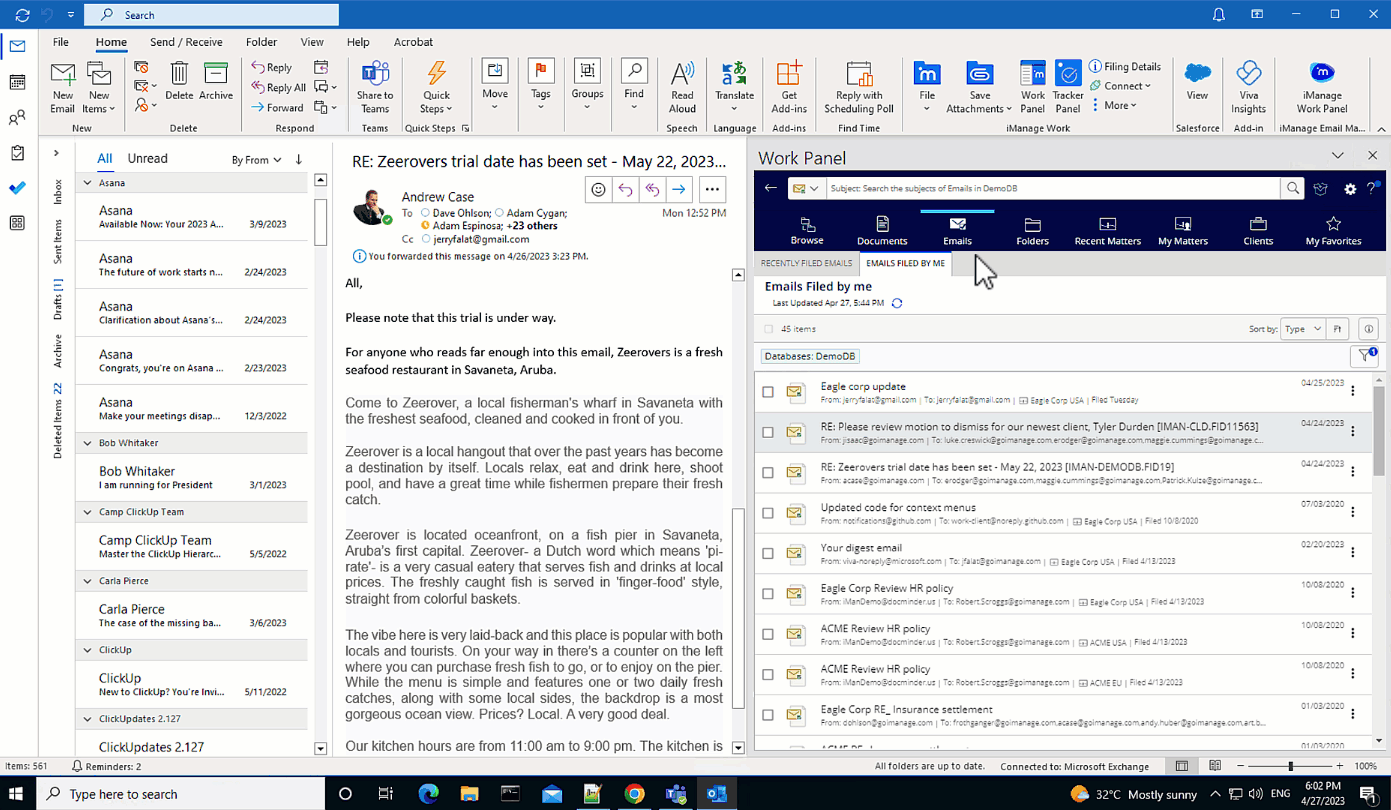
In the grid view, you can also add the Type column to sort .eml files for quick sorting.
Opening emails filed from Gmail, in Gmail using the right-click content menu
If you use the iManage Work for Gmail extension on Google Chrome to file emails from Gmail to iManage Work, then from now on, you can open such emails in the grid and list views from the Open right-click context menu/kebab menu as well as the preview window.
If your administrator has enabled the Enable open in Gmail setting in iManage Control Center, then, selecting Open from the right-click context menu/kebab menu opens the email in the Gmail web client.
Figure: Opening email filed from Gmail in the Gmail client
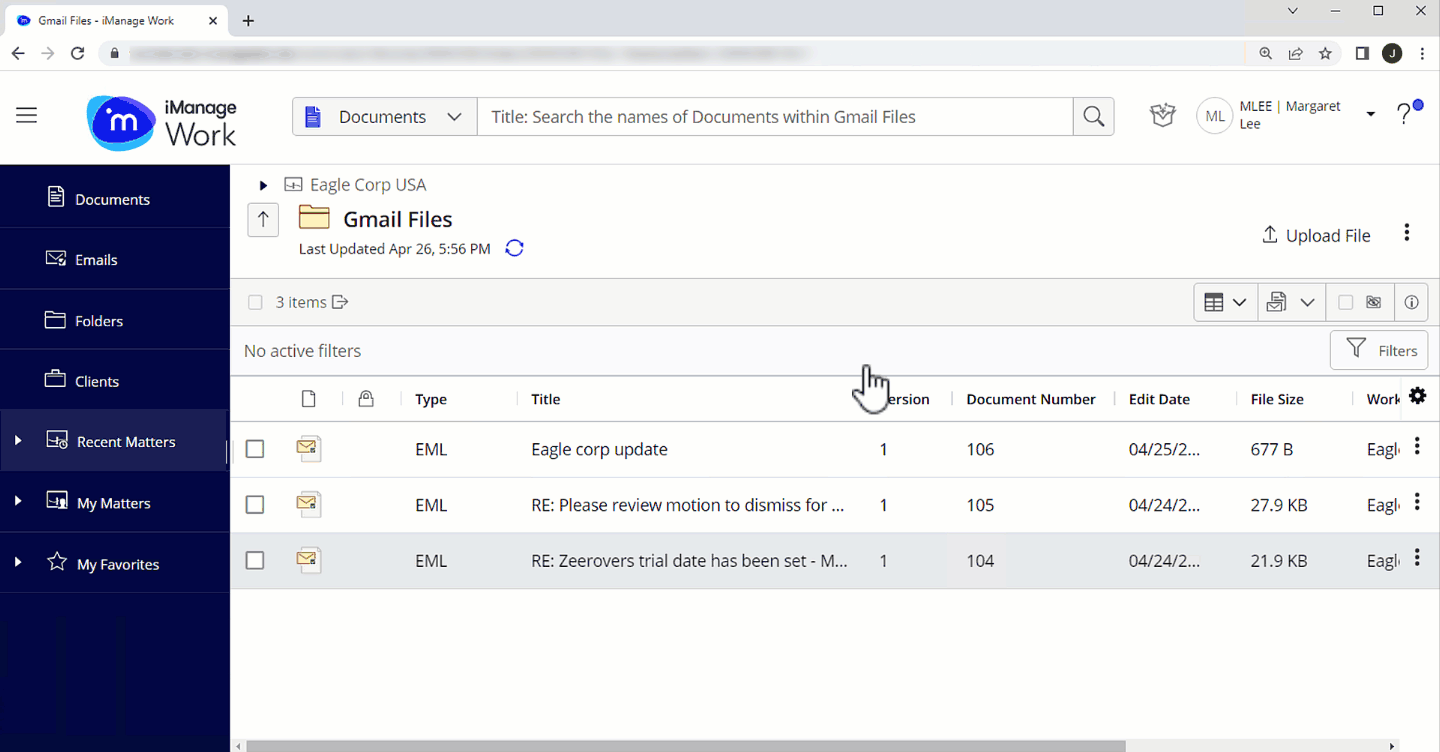
If your administrator has disabled the Enable open in Gmail setting in iManage Control Center, then, selecting Open from the right-click context menu/kebab menu opens the email using the iManage Work Desktop for Windows client.
Figure: Opening email filed from Gmail in the Work Panel
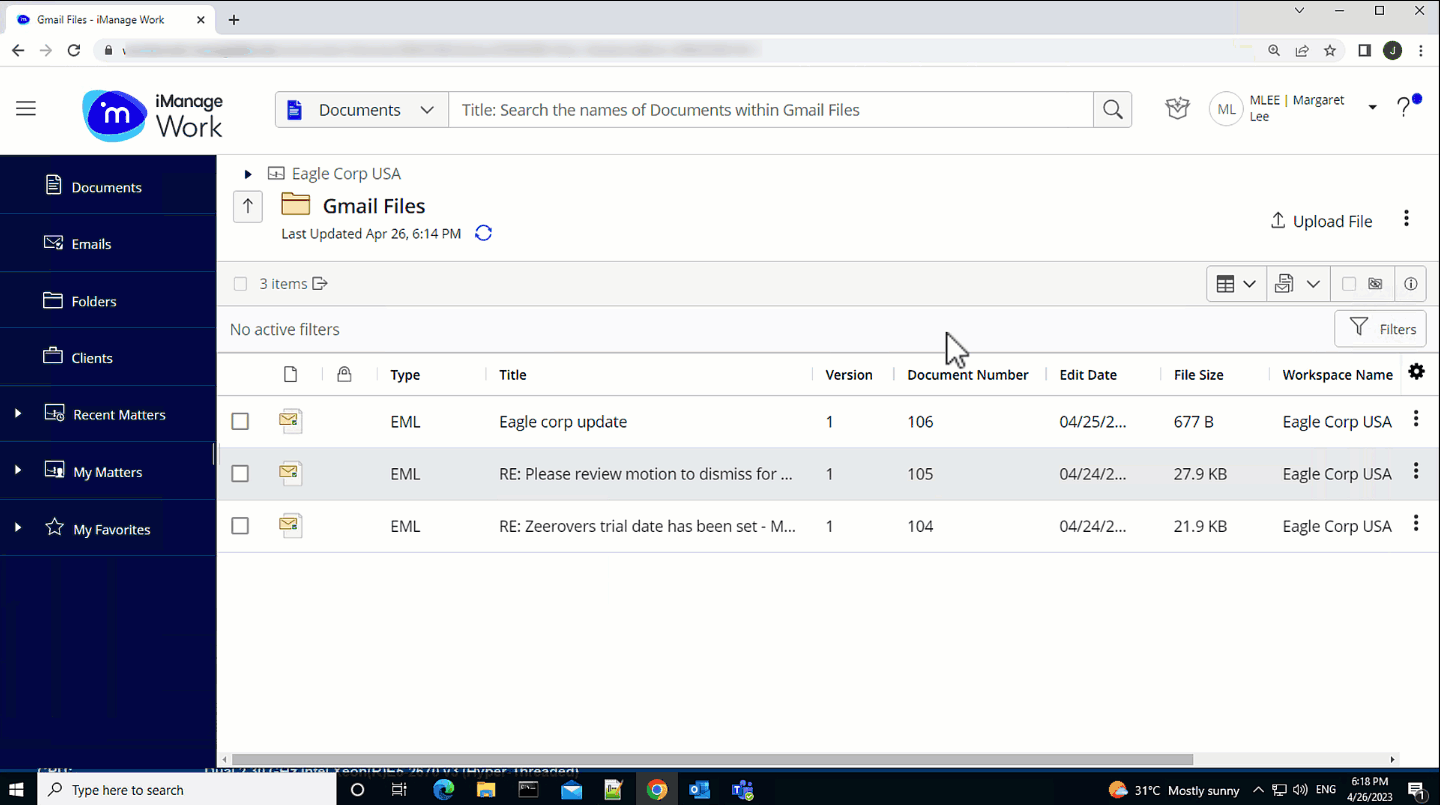
Improved accessibility
Enhanced support for keyboard navigation and clearer screen reader labeling in the New matter dialog box using the following keys:
Tab and Shift+Tab to move the focus among the form controls such as input field, drop-down lists, and so on.
Up and Down arrow keys to navigate through the suggestion lists within form controls.
Enter or Space bar to select the items.
Esc to close the dialog box.
iManage Share Agent enhancements
Improved stability and performance of the integration between iManage Share and iManage Work with greater availability of connections from iManage Work Server to iManage Share.
Disabling the administrator account or changing that password no longer disables access to iManage Share as it is only used at iManage Work Server start-up.
When an iManage Share blue folder is offline in iManage Work, users receive an error message instead of an icon, when trying to access it.
